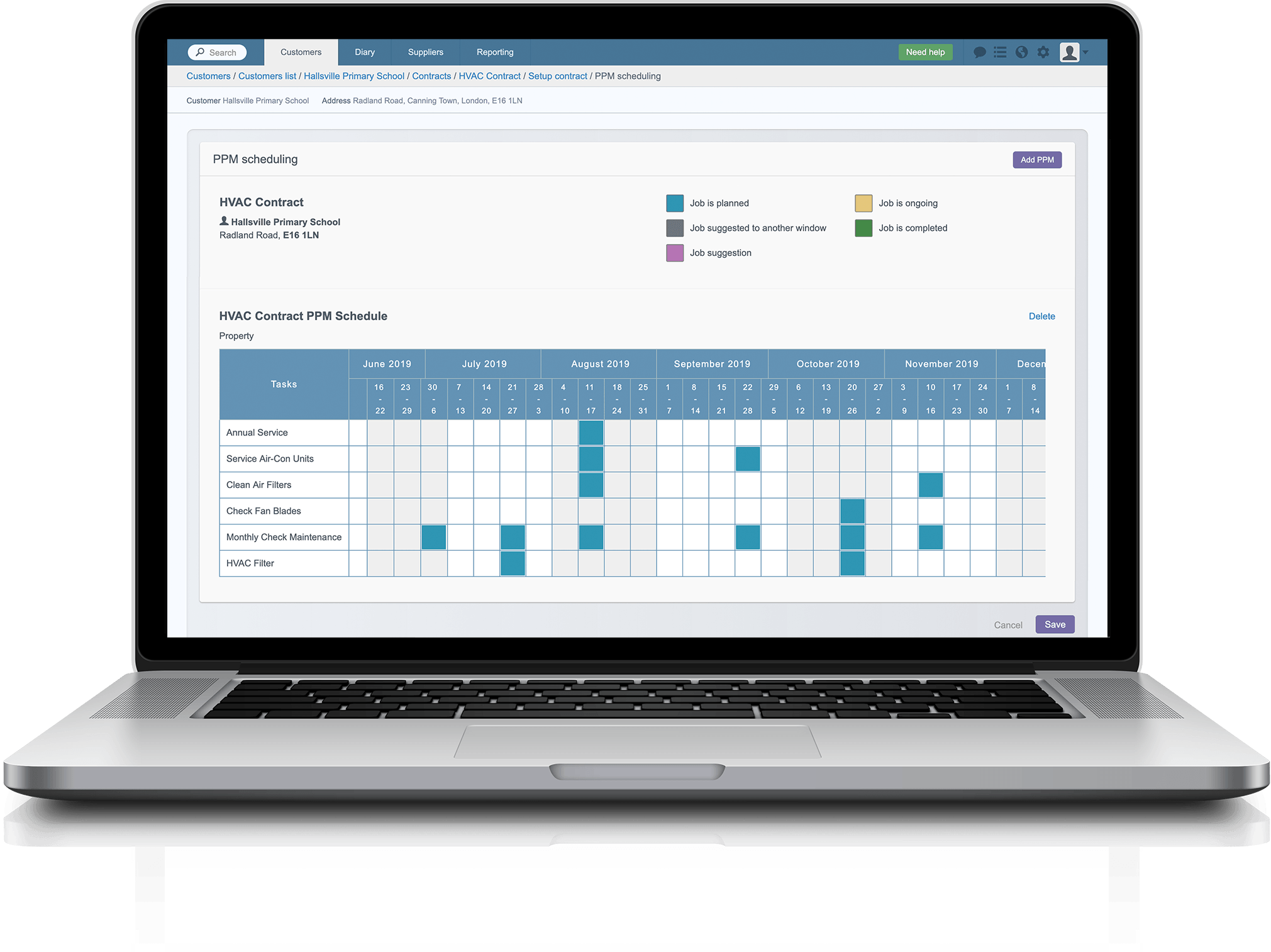Sustainable business growth is every fire and security company’s dream.
You know your good fortune isn’t a fluke, but you also know you need to work hard to yield great results next year too. A loyal customer base for your domestic work is one way, but individuals are fickle and it’s difficult to lay down profit forecasts when you’re not sure how much they’ll contribute to your bottom line. This is why maintenance contracts, whether they’re for private companies or the government, are essential for a fire and security business that wants to grow.
Many companies are discouraged from even tendering for maintenance contracts under the impression that only larger businesses win these, but often lose sight of the advantages they have over the big names, especially as the UK government has made it a focus to assign at least 33% of public contracts to SMEs (fewer than 250 employees) until 2020. Together with constant new developments and tech advancements, this has made room for companies of all sorts of sizes to start tendering.
This being said, it makes sense that you won’t be the first to figure out the opportunity. Competition is also on the rise, so you’ll need to put in every effort to stand out.
Remember that with maintenance contracts, you have a guaranteed income for the entire span of the contract, as well as the peace of mind that comes with preventive work, rather than just reactive. While it requires a lot more time, effort, and resources compared to waiting around for domestic customers, two or three maintenance contracts (depending on their size and your workforce) can set you up with significant profits for the foreseeable future. Therefore, it’s worth seriously considering these three decisions to help win you bigger contracts.
1. Create powerful reports
One thing that many companies underestimate is the importance of comprehensive reports, especially when competing with more experienced businesses. Winning big maintenance contracts is obviously about the standard of work you can deliver, but it’s rarely only about that. Having the best, most experienced engineers around is an advantage but it won’t get you anywhere unless you can prove that those engineers can minimize downtime on assets, ensure compliance with service level agreements, and have a minimal recall rate. And the keyword here is prove.
Big clients will want a strong track record in upholding service agreements. While recommendations have their place in a tender, it’s a considerable advantage if you can show (for example) that a previous client who once had an average downtime on their assets of 48h , reduced that number to under 12h after hiring your services.
These reports show what kind of company you are: diligent, structured and, most importantly, consistent
Managers and business owners are usually aware that tendering involves a lot of paperwork but more often than not, they’re thinking of financial planning and records. There are a lot of incentives in place to keep your financials organised – and for good reason, no one wants the tax man knocking on their door – but less so about tracking. This could be of your scheduling proficiency, recall rate, asset management, and other business efficiency metrics. But the fact of the matter is that these reports show what kind of company you are: diligent, structured and, most importantly, consistent.
Big companies want to know they can rely on a general standard of service in order to draw up their own reports and forecasts. They can’t afford to work with a company that’s haphazard about compliance. But it can be difficult for companies to compile these reports, even if your track record is spotless, no one will take your word for it if you can’t prove it.So, how do you do it…?
2. Be a digital-first company
Competing in this day and age implies staying up to date not only with your engineers’ training, accreditation, or tools of the trade, but also with business practices. A good manager will know when it’s time to switch gears and introduce new processes to support high business ambitions. This means going digital.
More and more, the type of customers who will judge those tendering for maintenance contracts will be looking for companies who can have what’s called “system-to-system” integration. This means that not only are you required to be a digital-first company, but your software needs to be flexible enough to integrate with that of your customers’, too. The purpose is to ensure transparency and accountability. That way, your customer stays in the loop and you can work together towards increasing efficiency.
In addition to these demands, tenders will ask “what innovation are you bringing to the table?”. There is no one right answer: it’s up to companies to come up with a way to impress. For example, a fire and security service level agreement can have hundreds of assets that need maintenance together with the ability to deal with reactive work on much tighter terms than in domestic situations. One solution would be asset tagging combined with a digital planned preventative maintenance strategy.
As buildings get smarter, so do the challenges that these customers face. Whether it’s facilities managers dealing with the challenge of mapping out assets or school boards having to conform with rigid regulations; fire and security companies need to prove that they can keep up.
3. Mobilise the contract
Once you’re done impressing the customer with your tech-savvy engineers and analytical attitude to business, you need to make a decision about how you plan to mobilise the contract.
In order words: how do you plan to enact the contract and get the job done? Most managers run into problems at this stage because they think enacting a contract means going about business as usual, scheduling engineers and sending them off on their way.
Mobilising a contract is a lot more work than that. It’s likely that you’ll have to hire additional employees to manage the new workload.
You also need to offer the customer details on how you plan to recruit, train, and onboard these new hires. Often, when a manger sits at the decision table, he’s accompanied by an HR specialist. You can hire your own or outsource, but make sure they’re there to inform the customer on how your company plans to draw up maintenance contracts, deal with problem-employees (everyone will have one at some point), and handle remuneration.
Your software can help again. For example, being able to track your vehicles in real-time, is a great way to prove that you’re (quite literally) ready to mobilise. It shows that you have a protocol to measure the efficiency of your engineers and know exactly where your assets are.
Even if you’re not the biggest amongst your competitors and you’ll have to hire more in order to uphold the SLAs, this type of preparation shows that you’re ready to put a great amount of effort into the contract. Customers will appreciate your dedication and zeal.
Bonus upcoming trend: Account for environmental concerns
One asset that can propel you to the top of the list when it comes to winning bigger contracts is your awareness of environmental responsibility. As climate change and pollution concerns mount, large companies are trying to do their part too. Whether it’s out of genuine preoccupation or because it’s good advertising, being able to guarantee that you’re committed to reducing, reusing, and recycling will give you a big advantage when tendering.
At the moment, it’s mostly public contracts that focus on this but more and more companies are striving to reduce their carbon footprints as legislation grows more stringent. Don’t forget to always focus on the benefits rather than list the things you’re going to do. Use your size to your advantage: if you’re a larger company, mention how you’re minimising travel time and fuel consumption with the help of GPS vehicle tracking systems. Combining those with dynamic scheduling that takes into account the distances between job addresses before producing a series of ideal diary appointments, can make a big difference when you have a larger fleet.
If you’re a smaller company, you have the flexibility to implement new, greener tech at a lower cost and train your engineers accordingly. You’ll likely encounter less resistance to change when compared to a larger company , and your service won’t be as disrupted. Your willingness to implement solutions like these could be what makes the difference between winning a contract and wasting time on pitches and paperwork.
The Takeaway
All in all, winning big contracts comes down to proving reliability and consistency. Don’t fall into the trap of thinking it’s always the lowest price that wins – that’s how many companies turn tendering into a fight to the bottom, where no one comes out a winner. Instead, focus on investing in opportunities where you know you have a competitive advantage over the competition who can’t keep up with the times. No doubt, you’ll bring back a considerable return on your investment.
Commusoft has been providing field service businesses with management software for over 15 years, helping them with intelligent scheduling, powerful reporting, asset management, vehicle tracking and many others. This experience has given us an edge in developing a software that integrates perfectly with every other aspect of a fire & security business.
For more details, book a demo with our team here.
Subscribe to the IFSEC Insider weekly newsletters
Enjoy the latest fire and security news, updates and expert opinions sent straight to your inbox with IFSEC Insider's essential weekly newsletters. Subscribe today to make sure you're never left behind by the fast-evolving industry landscape.
Sign up now!


